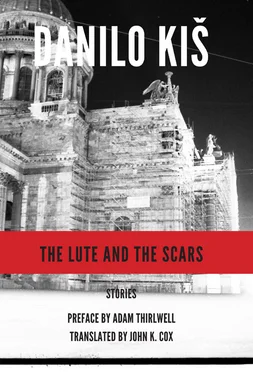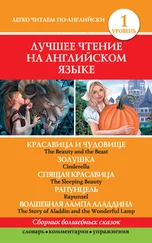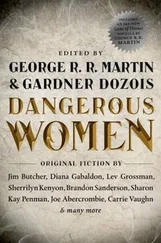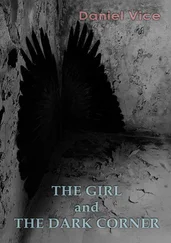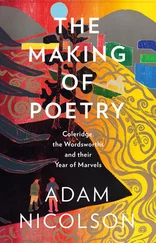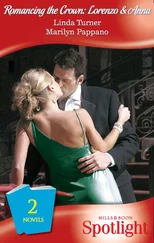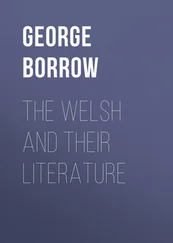3
Kiš’s unit was always very small. It was a manuscript, or legend: a brief life. Then he’d organise these brief lives into collage compositions — novels, or story cycles, or cycles of novels. By the last decade of his life, his stories were adding up to a scattered conspectus of the world’s crimes. The last book he published, The Encyclopedia of the Dead , came out in 1983. In a postscript, he described its theme: “All the stories in this book, to a greater or lesser extent, come under the sign of a theme I would call metaphysical: ever since the Gilgamesh epic, death has been one of the obsessive themes of literature.”
But there was an entire studio of other stories — which approached this theme more secretly, more tangentially. These stories, collected as The Lute and the Scars , are the final products of his factory for restoring lost lives. And in their delicate state, they therefore offer the most vulnerable version of Kiš’s art. The reader of this archive encounters all of Kiš’s acrobatics — his fake documents, true stories, the fantastical everyday: all his methods to keep trying to restore the dead to life. In “The Debt,” a life story emerges from a dying man’s hallucinated list of debts:
To Mr. Dinko Lukšić from Sutivan, whose hospitality made my days more pleasant and improved my health so that I could complete my volume of poetry: two crowns.
To the young investigating magistrate, a Viennese, who, on the occasion of my arrest in Split, allowed me to send for my personal effects, which had remained behind in my pension; he brought me Kierkegaard’s Either/Or , and that book would end up having a decisive impact on my intellect: two crowns.
In “The Stateless One,” it emerges through a prophecy; in “The Marathon Runner and the Race Official,” through a dream; in “The Poet,” through a legend. These stories, in other words, are a primer in the method of Danilo Kiš. They will make the reader Kišified. And so eventually this newly Kišified reader will note even smaller acts of restoration: like the smuggled list in the postscript to the story called “Jurij Golec,” where in the guise of describing a collection of furs, in order to just wearily prove an authorial point of verismo , his story becomes an arctic forest: “mink, silver fox, arctic fox, lynx, Canadian wolf, astrakhan, beaver, nutria, marmot, muskrat, coyote. ” Even a postscript is another way for Kiš to create truths, not fictions. Because, as he writes, in another list, created by the list of animals, these furs have now “found their way into the story through the back door, after the fact, unleashing new sensations, opening new worlds: métiers , market forces, money, adventure, hunting, weapons, knives, traps, blood, animal anatomy, zoology, far-off exotic regions, nocturnal animal noises, Lafontaine’s fables. ” Yes, writes Kiš, with careful irony, at the end of the end of this short story: “great are the temptations of a tale. In contrast to a novel, however, one may not, in a tale, open the doors of cabinets with impunity.”
4
So maybe I can put it like this. These exposed last stories from his studio prove that metafictional problems are in fact the ethical problems of history. They are different aspects of a single question: how do you restore the murdered to life? This is the deep question of Kiš’s fiction, and it’s one reason why his fiction represents an ongoing and future laboratory. His stories offer innovative, zigzagging ways of convincing a reader that a story is true. Why should there be a single method? He himself, as he recorded in an interview in 1976, with blunt technical clarity, had originally relied on the magical methods of the first person:
What I mean is that spells, incantations, charges (in Valéry’s sense) were the only literary means I had to win over my readers, convince them that the words they were reading were not mere idle fantasies but a form of truth and experience.
But then there was a shift.
In Hourglass , where I switch to the third person and therefore lose the confessional tone, I was forced to use other devices (objective images, invented footnotes, “documents”) so as to make readers believe, again, that they were reading more than fantasies or figments of the imagination, that they were reading the truth, and not only artistic truth .
And he added: “Call it commitment if you like: an enlargement of the circle of reality as well as an increase in the obligations resulting from it. ”
5
Yes, there are various ways of imagining a future world literature. And one of the most precious and wildest examples is the method of Danilo Kiš: this attempt to write minute encyclopaedias.
“I believe,” he wrote, “that in its ideal, unattainable, Platonic form the novel should resemble an encyclopedia entry or, rather, a series of entries branching out in all directions yet condensed.” A novel, in other words, should organise the maximum content in the minimum space. And it makes me think of the strangest text in The Lute and the Scars : just called “A and B.” It’s only a description of Kiš’s most magical place, followed by a description of his worst. The worst place — Text B — is a village hut, described in his manner of deep detail:
The walls have been whitewashed with an ochre-colored preparation made by dissolving clay in lukewarm water. The effects of dampness and sunshine are such that this coating blisters or develops cracks that look like scales or the faded canvases of Old Masters. The floor is also of pounded clay that lies several centimeters lower than the surface of the yard. On humid days the clay smells of urine. (A shed for animals once stood here.)
Whereas his magical place — Text A — is a place of total openness: a view of the sea from the mountains.
And you have to know for certain that your father traveled this same stretch of road, either on a bus or in a taxi he had hired in Kotor, and you have to be convinced that he beheld this same sight: the sun popping into view in the west from behind clouds that looked like a herd of white elephants; the high mountains dissolving in mist; the inky dark blue of the water in the bay; the city at the foot of the mountains.
But then this story or memoir or fragment ends with a postscript in a single sentence: “Texts A and B are connected to each other by mysterious bonds.”
And with that sketched sentence, I think, Kiš transforms his twin fragments into the smallest novel possible: a universal history of loss — described without psychology, or character, in a couple of pages.
There are various way of imagining a future world literature. And one of them, I just mean, is to realise that Danilo Kiš is there already.
ADAM THIRLWELL, 2012
* Save where indicated by the text, this and other quotes in the Preface are from Homo Poeticus: Essays and Interviews . ed. Susan Sontag, (New York: Farrar, Strauss, and Giroux, 1995).
1
“He arrived in Paris on May 28, 1928. ”
He took a room in a hotel in the Latin Quarter, close to the Odéon. This particular hotel filled him with melancholy thoughts, and in the evenings, when he’d turn off the lamp above his nightstand, he had visions of phantoms with long hotel sheets fluttering around them like winding cloths. One of these phantom couples was familiar to him, and our man without a fatherland refreshed the image in his mind of the poet and his lover as he had seen them once in a photograph in that poet’s scrapbook: she, Leda, with the enormous hat shading her face as if a veil were draped over her eyes, although it was a shadow that nonetheless failed to conceal the quiver of the years, barely visible, and of a certain sensuality starting to register around the lips; he, the poet afflicted with love and illness, his eyes bulging from Graves’ disease but still glowing with fire like the eyes of a Roma master violinist. That Leda’s troubadour had once lodged in this same hotel was a fact probably known only to the stateless one. Upon his arrival he asked the porter if a certain poet had stayed in the hotel around 1910. and he mentioned him by name. The young man, obviously confused by the foreign-sounding name, blurted out in his mother tongue: “ No comprendo, señor .” This proved to the stateless one yet again how irrevocably borders divide our world, and to what degree language is a person’s only real home. But, taking his key in his hand, he was already heading for his room on the third floor, on foot, half running up the stairs, because he had been steering clear of elevators of late.
Читать дальше
